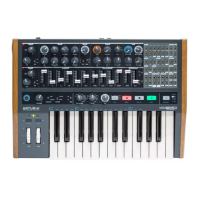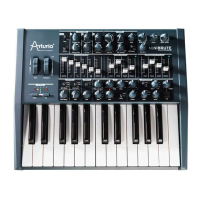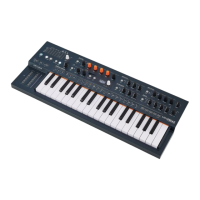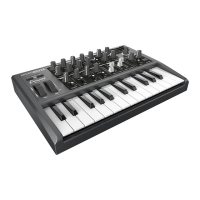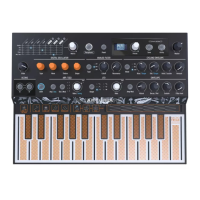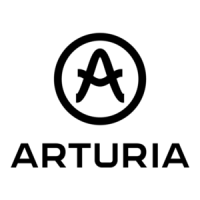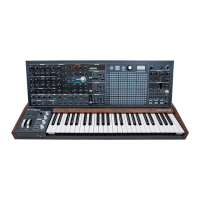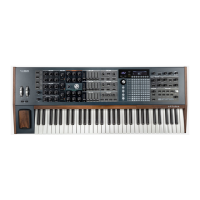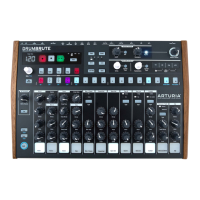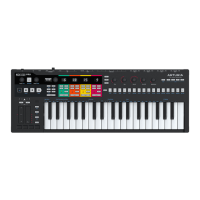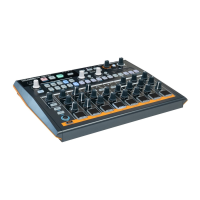Do you have a question about the Arturia MINIBRUTE 2S and is the answer not in the manual?
Introduces the MiniBrute 2S, its analog nature, and Arturia's design philosophy.
Highlights the MiniBrute 2S's analog sound, patch bay, and user experience.
Covers usage precautions, warnings, and basic installation steps.
Details connector types and how to connect the synthesizer to external gear.
Explains the importance of warm-up time and how to tune the instrument.
Guides the user through creating a basic patch and exploring initial sounds.
Demonstrates filter manipulation and LFO modulation for sound shaping.
Explains the AD and ADSR envelope generators and their function.
Introduces the Sync button and basic operation of the sequencer/arpeggiator.
Describes the primary features like pads, transposition, and arpeggiator.
Explains how the Shift button accesses secondary functions and parameters.
Introduces the main synthesis sections on the top panel.
Details the controls and functions within the sequencer section.
Covers all connectors and ports located on the rear panel of the device.
Explains LFO waveforms, sync, and rate controls for modulation.
Details the controls for Voltage Controlled Oscillators 1 and 2.
Covers filter modes, cutoff, resonance, and modulation sources.
Explains Brute Factor, Master Volume, and Global Tune.
Details the Osc Mixer sliders and signal enhancers like Ultrasaw.
Explains the fundamental principles of subtractive synthesis in analog synths.
Describes pitched (oscillators) and unpitched (noise) signal generators.
Details the function of filters and common modulators like LFOs and envelopes.
Introduces patch bay sections, inputs vs. outputs, and pre-wired connections.
Explains the patch points for VCOs, the Filter, and the Amplifier sections.
Details patch points for envelope generators, LFOs, and the VCA.
Covers patch points for attenuators, sequencer sync/reset, and MIDI data.
Details shared features like sync, metronome, tempo, time division, and swing.
Explains how pitch, transposition, and scale selection affect patterns.
Covers sync options (master/slave) and tempo control methods.
Guides through recording patterns in real-time and step modes.
Explains how to control pattern playback, including pausing and restarting.
Details how to transpose patterns using pads or external MIDI/USB.
Explains how to save, load, copy, and manage patterns across banks.
Describes the four sequencer tracks and their available types (Pitch, Gate, etc.).
Explains how to edit pitch, scale, and root note for sequencer tracks.
Details editing options for Velocity, Pressure, xV, Gate, Envelope, and LFO tracks.
Covers editing steps in Step mode and managing pattern pages.
Defines arpeggios and introduces Arpeggiator features like tempo and swing.
Explains how to use the Arp/Loop button, select modes, and control transport.
Guides on how to add multiple notes and octaves to create complex arpeggios.
Details how to pause, resume, and loop arpeggio patterns.
Explains how to set up and use the looper feature within patterns.
Describes how the sequencer and arpeggiator interact during playback.
Introduces the MIDI Control Center application and its system requirements.
Provides instructions for installing MCC and troubleshooting connection problems.
Explains how to browse, manage, and transfer templates and device settings.
Details MIDI controller settings, sequence parameters, and transport controls.
Covers transposition settings and configurable CV/Gate electrical behavior.
Guides on creating and applying custom user scales for patterns and arpeggios.
Provides a summary list of all available Shift button features.
Details the Shift function descriptions applicable in all operating modes.
Lists Shift function descriptions specific to modes like Step Recording or Pad Playing.
Contains important notices regarding FCC compliance and product modifications.
States compliance with Canadian and European regulatory standards.
Introduces the MiniBrute 2S, its analog nature, and Arturia's design philosophy.
Highlights the MiniBrute 2S's analog sound, patch bay, and user experience.
Covers usage precautions, warnings, and basic installation steps.
Details connector types and how to connect the synthesizer to external gear.
Explains the importance of warm-up time and how to tune the instrument.
Guides the user through creating a basic patch and exploring initial sounds.
Demonstrates filter manipulation and LFO modulation for sound shaping.
Explains the AD and ADSR envelope generators and their function.
Introduces the Sync button and basic operation of the sequencer/arpeggiator.
Describes the primary features like pads, transposition, and arpeggiator.
Explains how the Shift button accesses secondary functions and parameters.
Introduces the main synthesis sections on the top panel.
Details the controls and functions within the sequencer section.
Covers all connectors and ports located on the rear panel of the device.
Explains LFO waveforms, sync, and rate controls for modulation.
Details the controls for Voltage Controlled Oscillators 1 and 2.
Covers filter modes, cutoff, resonance, and modulation sources.
Explains Brute Factor, Master Volume, and Global Tune.
Details the Osc Mixer sliders and signal enhancers like Ultrasaw.
Explains the fundamental principles of subtractive synthesis in analog synths.
Describes pitched (oscillators) and unpitched (noise) signal generators.
Details the function of filters and common modulators like LFOs and envelopes.
Introduces patch bay sections, inputs vs. outputs, and pre-wired connections.
Explains the patch points for VCOs, the Filter, and the Amplifier sections.
Details patch points for envelope generators, LFOs, and the VCA.
Covers patch points for attenuators, sequencer sync/reset, and MIDI data.
Details shared features like sync, metronome, tempo, time division, and swing.
Explains how pitch, transposition, and scale selection affect patterns.
Covers sync options (master/slave) and tempo control methods.
Guides through recording patterns in real-time and step modes.
Explains how to control pattern playback, including pausing and restarting.
Details how to transpose patterns using pads or external MIDI/USB.
Explains how to save, load, copy, and manage patterns across banks.
Describes the four sequencer tracks and their available types (Pitch, Gate, etc.).
Explains how to edit pitch, scale, and root note for sequencer tracks.
Details editing options for Velocity, Pressure, xV, Gate, Envelope, and LFO tracks.
Covers editing steps in Step mode and managing pattern pages.
Defines arpeggios and introduces Arpeggiator features like tempo and swing.
Explains how to use the Arp/Loop button, select modes, and control transport.
Guides on how to add multiple notes and octaves to create complex arpeggios.
Details how to pause, resume, and loop arpeggio patterns.
Explains how to set up and use the looper feature within patterns.
Describes how the sequencer and arpeggiator interact during playback.
Introduces the MIDI Control Center application and its system requirements.
Provides instructions for installing MCC and troubleshooting connection problems.
Explains how to browse, manage, and transfer templates and device settings.
Details MIDI controller settings, sequence parameters, and transport controls.
Covers transposition settings and configurable CV/Gate electrical behavior.
Guides on creating and applying custom user scales for patterns and arpeggios.
Provides a summary list of all available Shift button features.
Details the Shift function descriptions applicable in all operating modes.
Lists Shift function descriptions specific to modes like Step Recording or Pad Playing.
Contains important notices regarding FCC compliance and product modifications.
States compliance with Canadian and European regulatory standards.
| Product type | Analog synthesizer |
|---|---|
| Product color | Black |
| Number of pads | 16 |
| Keyboard number of keys | - |
| MIDI in | Yes |
| USB ports quantity | 1 |
| Depth | 277 mm |
|---|---|
| Width | 484 mm |
| Height | 56 mm |
| Weight | 3500 g |
